JOB POSTINGS – CURRENT on UNDERWATERJOBS.COM
By CADC Admin ~ January 20th, 2022. Filed under: JOBS.
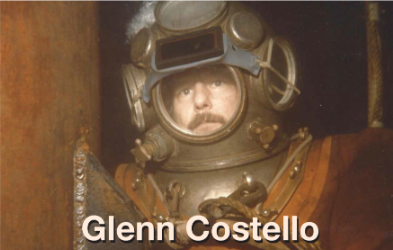 At the 2025 Canadian Underwater Conference & Exhibition in Vancouver, BC, the Diver Certification Board of Canada (DCBC) presented its Lifetime Achievement Award posthumously to Glen Costello—a respected commercial diving pioneer, founder of Canpac Divers Inc., and past president of the Canadian Association of Diving Contractors (2012–2014).
At the 2025 Canadian Underwater Conference & Exhibition in Vancouver, BC, the Diver Certification Board of Canada (DCBC) presented its Lifetime Achievement Award posthumously to Glen Costello—a respected commercial diving pioneer, founder of Canpac Divers Inc., and past president of the Canadian Association of Diving Contractors (2012–2014).
The award was accepted by his wife, Charlie Costello, during a moving ceremony that recognized a lifetime of groundbreaking achievements, unshakable ethics, and advocacy for diver safety.
Glen’s underwater career was built on a foundation of hard-earned experience—from military service in the Peace Keeping Corps in Egypt and the Middle East, to ironwork on major infrastructure projects, and finally into commercial diving where he left an indelible mark. As President of Canpac Divers from the early 1980s until 2012, Glen led deepwater projects involving ROVs, manned submersibles, salvage, and marine construction across Canada and abroad.
He was instrumental in organizing commercial divers under Local 2404 of the Pile Drivers, Divers, Bridge, Dock and Wharf Builders union, fighting for fair wages, pensions, and safe working conditions. He also contributed significantly to regulatory development, serving on CSA dive standards subcommittees and assisting in the formation of diving safety regulations for WorkSafeBC.
Glen’s technical experience was wide-ranging—hydrographic survey, NDT, submarine cable installation, ROV work, salvage—and his willingness to share knowledge made him a mentor to many. His integrity, persistence, and unwavering commitment to diver safety made him a fitting recipient of this national honour.
The CADC congratulates Charlie Costello and the Costello family on this well-earned recognition of Glen’s enduring legacy. His contributions continue to shape our industry and the standards we uphold today.

(This is a public service announcement from the CADC to all diving contractors – April 20 2025)
A recent legal decision out of New Brunswick Feb 2025 has major implications for all of us in the commercial diving sector as well as any industrial or commercial construction industry. Don’t ignore the warning.
In King v. R., 2025 NBCA 12e, the New Brunswick Court of Appeal upheld a criminal negligence conviction against a worksite supervisor after the death of an 18-year-old worker. The supervisor, who failed to follow basic confined space safety protocols, was sentenced to three years in prison. His actions—or more accurately, his inaction—cost a young worker his life.
This decision wasn’t about fines. It wasn’t about policy violations. It was about criminal accountability under Bill C-45—Canada’s Westray Law. And for anyone directing high-risk work like commercial diving, the message could not be clearer: if you neglect safety and someone dies, you may go to jail.
In the King case, a leak test was conducted in an 8-foot confined space while a young worker remained inside. No hazard assessment was done. No emergency plan was in place. No confined space procedures were followed. The supervisor didn’t read the equipment’s safety manual. He never warned the worker the space was going to be flooded. The result was fatal.
The court ruled this was a marked and substantial departure from what a reasonable supervisor would have done. They confirmed that a “common sense” hazard like flooding a confined space during a leak test was enough to establish criminal negligence.
Let’s be clear—this could have easily occurred in a commercial diving context: confined space entries, pipeline work, tanks, lockout-tagout failures, inadequate supervision, or improperly briefed divers. The parallels are unmistakable.
This case sends a message to supervisors and employers across Canada—the courts are prepared to impose jail sentences when safety is ignored. In the diving industry, where hazards are immediate and often life-threatening, we must assume the legal threshold is even higher.
In the case of CADC members, we are expected to meet—and in many cases exceed—the safety standards laid out in CSA Z275.2 and Z275.4. These are not just best practices—they are often incorporated directly into law. Courts will judge our actions against these standards if things go wrong.
For CADC Contractors – and Dive Contactors in general – and Supervisors:
For Clients Who Hire CADC Members and ANY diving Contractor:
King v. R. wasn’t about policy. It was about accountability. The case proved that criminal negligence laws under Bill C-45 apply to supervisors and companies who ignore known risks.
In our industry, we are often dealing with confined space entries, delta P, unstable environments, heavy lifting, and pressure systems. If a diver is hurt or killed because a hazard was ignored, the legal consequences can be catastrophic—for the supervisor, the employer, and potentially the client.
Don’t assume this can’t happen to you or your team. Now is the time to act:
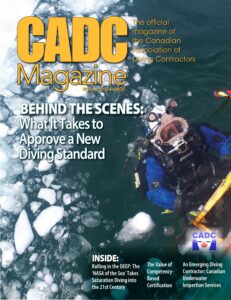 One glance outside at the weather in December is all it takes to remind us that winter is here, along with its ice and snow, and all the unpredictable changes to climate that makes life more challenging. But, as we in the industry know, commercial diving was never meant to be easy.
One glance outside at the weather in December is all it takes to remind us that winter is here, along with its ice and snow, and all the unpredictable changes to climate that makes life more challenging. But, as we in the industry know, commercial diving was never meant to be easy.
This is a profession that demands precision, calculated risks, and the ability to solve problems in the most challenging environments. Every dive balances expertise, experience, and safety protocols, with lives depending on getting it right.
In this issue of CADC Magazine, we shine a light on the work, innovation, and regulations that keeps our industry moving forward and set new standards for safety, professionalism, and ingenuity.
A CADC Magazine deep dive In the cover story, ‘Behind the Scenes: What It Takes to Approve a New Diving Standard,’ I guide you through the often tedious but critical process of developing new safety standards. From identifying gaps to navigating red tape to gathering input through public reviews, the article highlights the dedication required to ensure divers return home safely. It’s a long, detailed journey, but one that’s essential to saving lives and upholding the professionalism of our industry.
Kirk Krack’s feature, ‘Rolling in the DEEP: The ‘NASA of the Sea’ Takes Saturation Diving into the 21st Century,’ explores how DEEP is revolutionizing saturation diving with their groundbreaking subsea habitats, Sentinel and Vanguard. Inspired by Canadian diving pioneers such as Dr. Joe MacInnis, DEEP is redefining what’s possible in underwater exploration. Imagine living and working comfortably on the seabed – it’s habitat living version 2.0!
Written by Bob Clarke of ASI, ‘The Isolation of Failed Piping Using Remotely Operated Vehicles’ demonstrates the ingenuity of ROV technology in tackling complex underwater challenges. Detailing projects at British Columbia’s This is a profession that demands precision, calculated risks, and the ability to solve problems in the most challenging environments. Every dive balances expertise, experience, and safety protocols, with lives depending on getting it right.
Winter 2024-2025 up front requirements, the article underscores CSA’s commitment to evolving safety and operational needs. Safer, smarter, better At its core, this issue of CADC Magazine reflects the intentional effort and collaboration required to make the commercial diving industry safer and smarter. Excellence does not happen by chance – it is built on dedication and an unyielding drive to improve.
Whether it’s advancing safety standards, embracing new technologies, or showcasing stories of resilience and innovation, this edition is filled with practical insights you can apply in your work.
So, grab a coffee, watch the snow fly, and dive into the pages ahead. These stories are more than words – they’re a call to action for all of us to keep pushing boundaries, solving problems, and leading the way in commercial diving.
Remember, it’s cold out there, but the water below the ice is always a steady 0°C (32°F). Being a tender in Canada’s winter might suck – but we wouldn’t trade this work for anything. Welcome to our world. Stay safe, and all the best in the New Year!
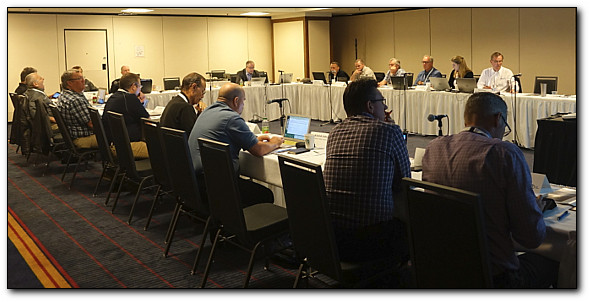 In the commercial diving world, standards aren’t just paperwork – they’re lifelines. They are what stand between a diver and the myriad of risks that lurk below.
In the commercial diving world, standards aren’t just paperwork – they’re lifelines. They are what stand between a diver and the myriad of risks that lurk below.
But how does a diving standard actually come to be?
It’s easy to imagine a few folks in a boardroom, shaking hands and signing papers, but in reality, the journey from idea to official standard is long, winding, and full of obstacles. Anyone who’s ever been involved in this process knows it’s more like navigating a labyrinth of approvals, discussions, and – yes – more than a fair share of red tape.
The Canadian Standards Association (CSA) Dive Committee meetings in November recently gave new Canadian Association of Diving Contractors (CADC) members a glimpse into just how much bureaucratic weight can slow down a well-meaning initiative.
Here’s a behind-the-scenes look at what it really takes to get a diving standard approved, why it’s worth the hassle, and why it can sometimes feel like you’re swimming upstream.
Step one: identifying the need
It all starts with a need.
Maybe there’s a new technology in the field, a recent accident that exposed a safety gap, or a fresh environmental factor that diving operations need to account for. This need is often flagged by industry experts, safety consultants, or even directly from divers and operators experiencing issues in the field. It’s a grassroots beginning, but without this on-the-ground intel, we wouldn’t know where our standards might be falling short.
Once the need is identified, it’s flagged by CADC and others for review by CSA or similar regulatory body. Think of this as the stage where you bring your idea to the door, knock, and wait to see if they’ll answer. Often, it can take months – or even years – before a perceived gap becomes a priority on the standards agenda.
Step two: building the working groups
Once the need has been acknowledged, a working group of stakeholders is put together. This isn’t your average office committee. In the case of diving standards, you’re talking about a blend of experts, commercial divers, dive companies, engineers, manufacturers, medical professionals, regulatory representatives, training groups, and safety inspectors.
The goal? To gather every possible perspective to address the identified need comprehensively. But here’s where things start to get tricky.
Each member brings their expertise – as well as their biases. What a diver prioritizes might differ from what an engineer or regulator considers critical. Medical experts might push for more stringent health standards, while manufacturers focus on practicalities of equipment specs. It’s the classic case of too many cooks in the kitchen, and every cook thinks their ingredient is essential.
The result? Hours of debate, compromise, and more than often, sometimes a few heated arguments.
It’s in these meetings where red tape really starts to show. Every proposed change or addition has to be examined from every angle. What if this requirement adds prohibitive costs for contractors? Will it impact the timeline of a job? How do we ensure every diver in the country can meet this standard? And the ultimate question – how do we measure and enforce it? Every decision has ripple effects and the working group must weigh them all.
Step three: drafting the standard
Once the group reaches a tentative consensus, which is a Herculean task in itself, the drafting begins. This isn’t about just putting ideas down on paper; it’s about crafting clear, measurable language that leaves no room for ambiguity. The standard must be legally sound, scientifically accurate, and – ideally – practical to follow in the field. This can take several drafts, with members of the working group scrutinizing each word to ensure it covers the necessary ground without over-complicating things.
At this stage, the red tape turns technical. Every clause is analyzed for loopholes, conflicts with existing standards, and unintended consequences. Lawyers may step in to ensure the language is legally sound, and medical experts will review health guidelines. Engineers will go over every technical aspect to ensure the feasibility of equipment standards. It’s meticulous, mind-numbing work, and any misstep could lead to confusion – or worse, a dangerous gap in safety.
Step four: public review and industry feedback
Once the draft is finished, it goes out for public review. This is where industry professionals, diving contractors, and even the public get a chance to weigh in. It’s a critical part of the process, but it also introduces another layer of delays. Every comment or suggestion needs to be considered and responded to, often leading to more revisions.
During this stage, practical feedback from those who will actually use the standard – divers, supervisors, and contractors – is especially valuable. Sometimes suggestions will reveal unforeseen challenges in applying the standard to real-world scenarios. For example, a seemingly simple requirement might not work in remote or harsh environments where resources are limited. Each piece of feedback is carefully considered, and adjustments are made where needed.
Public review is a double-edged sword; it’s essential to catch potential oversights, but it can also bog down the process with contradictory suggestions, industry resistance, or calls for broader exemptions. Striking a balance is no easy feat.
Step five: approval and implementation
Once every hurdle has been cleared, the standard is finally submitted for formal approval by the CSA main Technical Committee, which can involve multiple rounds of voting and final reviews. Even at this stage, unexpected setbacks can arise. Maybe a government agency requests additional data, or a legal issue surface that needs ironing out. But if all goes well, the standard is finally approved and published.
Then, there’s the challenge of implementing the new standard. Training programs need to be updated, equipment may need upgrades, and divers and supervisors must adjust to new procedures. For those who’ve invested time and energy into the standard’s creation, this is the payoff. But for the industry, it’s the beginning of a learning curve, and sometimes a steep one.
Why bother with all this red tape?
If this sounds like a lot of work; it’s because it is. So, why do we go through this lengthy and bureaucratic process?
Simple: because lives are on the line. The stakes in commercial diving are high, and a poorly designed standard could mean the difference between life and death for a diver in a high-risk situation. It’s a serious commitment, and one that everyone involved takes personally.
It’s easy to get frustrated with the red tape and the endless meetings, but every hour of debate, every draft revision, and every piece of feedback brings us closer to a safer industry. These standards aren’t just words on a page – they’re the invisible supports that keep divers safe and bring them back to the surface, day after day.
So, the next time a new standard is released, take a moment to appreciate the behind-the-scenes work that went into it. It’s not glamorous and it’s rarely quick, but it’s always essential.
Doug Elsey is the Executive Director of the Canadian Association of Diving Contractors. He has been working in the commercial and military diving industry for more than 45 years.
(Pre Print – Winter 24-25 CADC Mag)
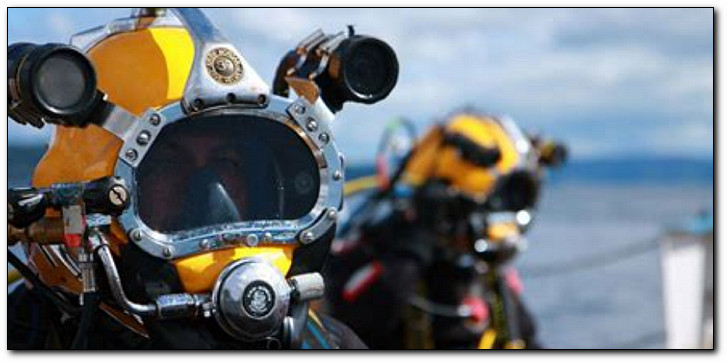 In November 2001, it was announced at a CSA meeting in Toronto that the Canadian Association of Diving Contractors (CADC) under the leadership of their Executive Director Jim Wilson, was going to lead the development of a federally regulated not-for-profit organization to certify the competence of divers across Canada. The goal was to replace the system that the National Energy Board (NEB) had put in place in the late 1980’s, a system that the NEB had declared was no longer part of their purview.
In November 2001, it was announced at a CSA meeting in Toronto that the Canadian Association of Diving Contractors (CADC) under the leadership of their Executive Director Jim Wilson, was going to lead the development of a federally regulated not-for-profit organization to certify the competence of divers across Canada. The goal was to replace the system that the National Energy Board (NEB) had put in place in the late 1980’s, a system that the NEB had declared was no longer part of their purview.
Everyone wanted them to succeed, and with good reason. The value of competency-based certification by an independent, nationally recognized organization was apparent to all present.
Divers saw the value in replacing a plethora of certificates with one nationally recognized certificate showing their principal diving qualification on the front, and various endorsements on the back. A certificate issued by the Diver Certification Board of Canada (DCBC) accomplished this mostly because it was designed by divers for divers. While the CEO was an expert in terms of competency and certification, he was not a diver.
Supervisors were supportive because they also wanted a single certificate which showed all of their qualifications. They also wanted to be sure that the divers they worked with were as qualified as they said they were. Having a certificate issued by a national independent body gave them confidence in their divers. Contractors were similarly pleased to have a reliable source from which to obtain verification of competence and experience.
Over time, regulatory bodies came to appreciate the competency certification provided by DCBC. Regulators no longer had to go through the lengthy process of certifying divers. They had only to write in their regulations that divers had to be proven competent as described in the CSA Competency Standard Z275.4 and then look for a DCBC certificate. CSA Z275.4 applies to occupational diving, hyperbaric facility, and remotely operated vehicle (ROV) operations conducted in connection with all types of work and employment and describes the requirements for minimum competency levels for all personnel directly associated with the identified techniques of diving or ROV operations. Canadian safety and health legislation requires that all workers be competent to perform the work assigned to them. It requires competency in both the theory and use of the type of diving apparatus or ROV employed. This Standard had been established to provide diver and ROV training facilities, and the diving and ROV industry, with a uniform minimum level of competency necessary for the various levels of diver and ROV techniques. Currently the DCBC is the only Canadian national organization that certifies diving and ROV personnel as meeting the CSA Standard.
As mentioned, commercial diver certification in Canada was first put in place by the National Energy Board (NEB) in the mid to late 1980’s in support of the development of the oil and gas fields off the coasts of Newfoundland and Nova Scotia. Canadian divers who held NEB certificates had international recognition, particularly from those nations working in the North Sea. Those divers wanted to retain their international recognition therefore DCBC’s CEO was dispatched to the UK to discuss the issue with officers of their Health and Safety Executive (HSE), and of the International Marine Contractors Association (IMCA). Discussions with the HSE led to an agreement that national diver certifying bodies had to have national government oversight and be totally independent of the commercial diving industry in each country. Thus began the total separation of the CADC and DCBC.
The result was an independent certification system (DCBC) which retained for Canadian offshore divers the international recognition they had grown to enjoy under NEB. The meetings with HSE, followed soon after by meetings with Paul Butler of the Australian Diver Accreditation Scheme (ADAS), led in short order to the creation of the International Diving Regulators Forum, later to become the International Diving Regulators and Certifiers Forum (IDRCF) involving Australia, Canada, France, Norway, South Africa and the United Kingdom. The IDRCF guaranteed Canadian unrestricted surface supplied divers world-wide recognition, all based on competency-based certification. In the following years the IDRCF was expanded to include IMCA and ADCI of the United States.
Clients looking to hire competent contractors to guarantee themselves a successful outcome, also wanted to protect themselves from liability issues by doing due diligence. More and more operators (clients) have begun to hire Inshore Diving Safety Specialists (IDSS), certified by DCBC as having at least eight years experience in at least seven areas of diving expertise. Any diving supervisor with eight years of experience would appear to be competent in most aspects of diving however while experience and competence complement each other, they are different; competence can be measured whereas experience cannot.
That is perhaps why IMCA has put into place a Continued Professional Development program. In order to retain good standing in IMCA, supervisors have to study experiential safety reports and complete regular, quarterly assessment exams in order to demonstrate continued proficiency, or competence. Once again, competence can be measured whereas experience cannot.
The DCBC certification is based on the CSA Competency Standard, CSA Z275.4. This Standard goes far beyond simply requiring a certain number of hours of training; it includes specific competency elements involving diving theory, tools, burning, welding and various underwater activities at specified depths. For example, to be considered competent each diver must complete a diver rescue at 165 fsw, in addition to the plethora of other underwater skill described in the standard.
DCBC has put in place a program that allows any diver or diving supervisor to demonstrate the competencies required of the standard, whether their initial training was in Canada or overseas. The Prior Learning Assessment & Recognition (PLAR), is a process that allows divers to apply their previous diving and training experience towards a DCBC certificate. If the assessment review shows a diver is lacking in any specific competency, they can attend an accredited training establishment and demonstrate those competencies. The system is designed to include every competent person, not to exclude them.
The bottom line is that competency-based certification demonstrates to the world that you are competent to carry out the duties that are required of a person in your position. It is the strongest performance indicator to any potential employer, no matter at what level you are employed.
Author: DCBC Nov 2024

It’s summer 2024 and its busy!!! Busy in a good way! All CADC members are indicating a hectic season. At the same time, they are also noting that the crazy period of last year with a shortage of divers is leveling itself out. Some infrastructure projects that fired up last year are continuing and crews and contracts are in place. So – it is also busy in a steady way! Indicators are that it is about to get busier yet!!
It’s the same here at the CADC office as we deal with various meetings on regulatory changes and initiatives – namely stressing to regulators to get up to speed on current best practices and change the regulations. As usual, we seem to run into the same red tape on change, elections coming up and as such, regulators seem to be focusing more on drifting along rather than moving around. If you detect frustration, you have it right!!!
The Canadian Association of Diving Contractors (CADC) – in our article “CADC Sets the Standard” – traces the CADC’s journey from its start, responding to the National Energy Board’s call for a unified voice, to its ongoing efforts in standards, regulations and industry representation within our industry. It’s been a long journey, but we are significant strides in our efforts to contribute to the our occupational / commercial diving sector. We have a crucial role ensuring safety and competency nationally across the industry. An interview with our present and past presidents showcases their impression of our efforts. (Spoiler: We are getting it right!!)
The new CEO of the Diver Certification Board of Canada (DCBC) Tracy Childs shares her personal reflection on the DCBC journey and vision for the future. With extensive experience in the diving certification process in Canada, the new CEO emphasizes the continuity of DCBC’s mission to enhance safety and competency. The article offers a glimpse into the CEO’s visits to accredited schools and international collaborations, highlighting a strong commitment to supporting high standards. Tracy has got this!!
This is a heads up for the “owner” when hiring a diving contractor. Ontario Ministry of Labour’s Matthew Neundorf’s insightful piece, “Who’s Responsible When Things Go Wrong?”, delves into the Internal Responsibility System under Ontario’s Occupational Health and Safety Act. Neundorf, a Provincial Specialist, clarifies the shared responsibilities among divers, employers, and insurance companies. This article serves as a crucial reminder of the legal and ethical duties necessary to ensure safe diving practices by the owner as well as the contractor. If you are an owner – you bear responsibility for what happens on a dive site that includes diver safety!!
David Parkes, the former CEO of DCBC, takes us on a historical journey through the organization’s evolution in his feature, “DCBC: Where it All Began.” Parkes recounts the founding of DCBC following the National Energy Board’s announcement and details its establishment of national standards and international collaborations. His narrative provides a comprehensive overview of DCBC’s significant impact on the diving industry over the past two decades. (David was honoured this year by CADC for his significant contribution to the diver certification process in Canada – and promoting it internationally for recognition.
Our member spotlight this issue presents an inspiring story of Aquatech Diving & Marine Services Ltd. in Alberta. Founded by John Dickau and now owed by Steve Berube, Aquatech has evolved from humble beginnings into a leading provider of industrial hazmat, search and recovery, and potable water diving services. The article highlights Aquatech’s unwavering commitment to safety, innovation, and community service, emphasizing its growth and success in the competitive diving market.
In “ROVs: A Diver’s Best Friend,” Chad Gillen from Deep Trekker Inc. discusses the integration of Remotely Operated Vehicles (ROVs) in diving operations. Gillen emphasizes the complementary roles of ROVs and divers, showing how technology can enhance safety, efficiency, and data acquisition in various underwater tasks. This article paints a compelling picture of the future of diving, where human ability and technological innovation work hand in hand.
These articles collectively reflect our ongoing commitment to safety, innovation, and excellence in the commercial diving industry. As we navigate the challenges and opportunities ahead, I hope these stories inspire and inform your work. Thank you for your continued support and dedication to advancing our field. It’s a long journey to make our industry safe, efficient and professional. We are all part of it.
DIGITAL VIEWING:
Participate – it’s your industry.
Stay safe …
Doug Elsey
Executive Director, CADC
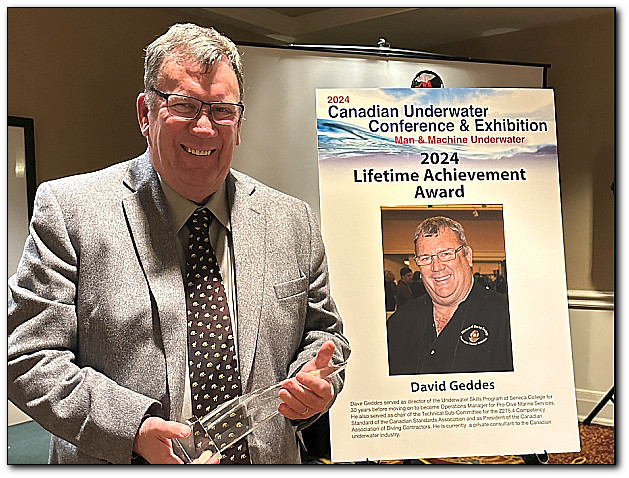
The recipient of this year’s DCBC Lifetime Achievement Award is Dave Geddes, recognizing his outstanding contributions to the Canadian Occupational Diving industry. With a career beginning in the early 1980s, Geddes has profoundly influenced the field through his leadership roles, including over 30 years as the director of Seneca College’s Underwater Skills Course and his active involvement in the CSA Dive Standards. As the subcommittee chair for the Z275.4 Competency Standard and a former president of the Canadian Association of Diving Contractors, Geddes has been a pivotal figure in advancing diving safety, education, and competency standards. His dedication and expertise have not only earned him the CSA Award of Merit but also solidified his status as a key advocate and recognized expert in diving safety and education. This award is a testament to Dave’s enduring impact and his significant contributions to the industry.
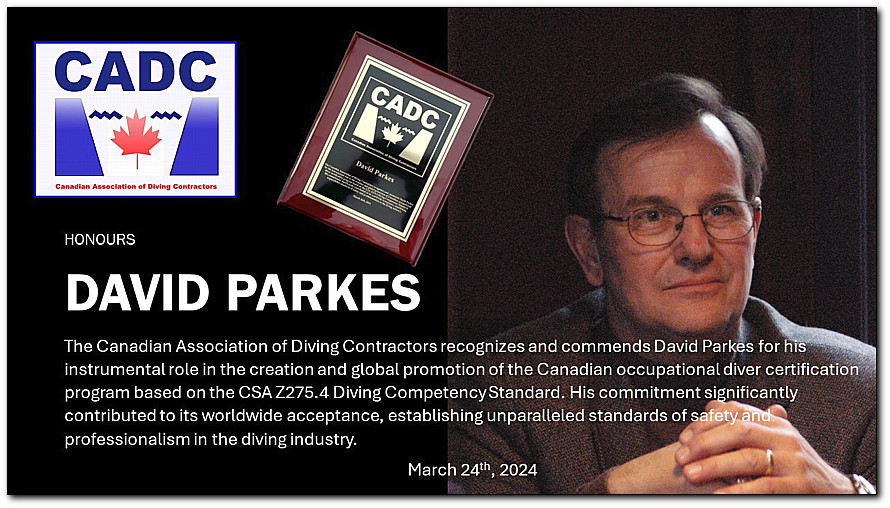
At the Canadian Underwater Conference and Exhibition held in Toronto March 23-26, the Canadian Association of Diving Contractors honoured David Parkes for his work at the Divers Certification Board of Canada.
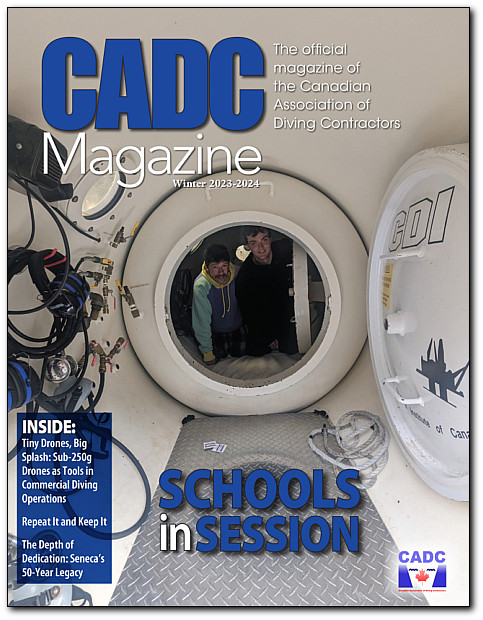
It seems to be a great time to be a diver! From the past year, all we have heard from the dive and marine contractors are “Where are the divers?” There is definitely a shortage of qualified and competent personnel in the industry right now. In fact, it has been that all year. There is a LOT of work out there right now and will continue into the new year.
The commercial diving personnel shortage of qualified divers – besides the increased demand for their talents – is also due in part to closure of prominent training programs like Seneca College’s diving program and two facilities in the US. The scarcity of such training facilities significantly contributes to the reduced number of new, skilled divers entering the workforce. These events happened over the last two years, and we are feeling it’s effects now. The limited number of commercial diving schools to take up the slack across the country further exacerbates the issue, restricting the training opportunities available for aspiring divers.
This shortage poses multiple challenges and risks in the industry. As the demand for commercial diving work increases, there is a concern that companies might employ undertrained divers, leading to illegal operations and heightened safety risks, including potentially fatal accidents. The role of commercial divers is critical in various infrastructure projects such as water treatment, facilites maintenance, nuclear facilities, and new underwater construction, means their shortage can have widespread economic and operational impacts. Moreover, the necessity for divers to periodically seek recertification—now potentially requiring relocation due to the closure of local training centers—adds an additional hurdle, possibly deterring individuals from pursuing or continuing careers in commercial diving.
This issue of the CADC magazine showcases the CADC member dive schools who specialize in the skills required to operate both in and outside our borders.
The cover story highlights standout commercial diving schools in Canada. Atlantic Commercial Diving Centre (ACDC) in Prince Edward Island excels in underwater welding and offers state-of-the-art facilities. The Commercial Diving Institute of Canada (CDI), based in British Columbia, is affiliated with heavy civil and offshore sectors, providing internationally recognized training. DiveSafe International, arguabley Canada’s largest dive school, located on Vancouver Island, exceeds CSA and DCBC standards, offering in-ocean training in real-world conditions. Lastly, the Institut Maritime du Québec (IMQ) provides college-level marine sector training, featuring a variety of natural learning environments and state-of-the-art equipment. Each school has unique offerings, contributing significantly to the training of skilled commercial divers.
Our featured CADC member “Expertech Marine,” founded by CADC director Marc-André Désy in 2008, is a one-stop-shop located in Québec City, specializing in underwater operations for port, industrial, and municipal infrastructure. Désy, a former commercial diver turned metallurgical engineer, established the company post-recovery from a severe motorcycle accident. Expertech employs 30 people, including 20 divers, and emphasizes teamwork and a family-like atmosphere. The company’s success is attributed to continuous investment and a strong team. It adheres to CSA standards and actively participates in the Canadian Association of Diving Contractors (CADC), valuing safety, performance, and community connections. Looking ahead, Désy plans to launch Expertech Erosion, focusing on innovative concrete mat solutions for erosion control and environmental restoration.
Sub-250g drones, compact yet powerful, are carving a new niche in operational efficiency and safety. An article by Doug Elsey of the Canadian Association of Diving Contractors, showcases these mini drones that are challenging preconceived notions with their surprising capabilities. From enhancing site surveys to aiding in search and rescue missions, these tiny technological marvels are not just a novelty but a vital tool, reshaping the landscape of underwater operations. As we delve into this story, we explore how these small drones are making a big splash in the commercial diving world by our CADC members.
Brain-dead or just “forgetful”? In a dynamic twist on the world of commercial diving, David Parkes, CEO of the Diver Certification Board of Canada, addresses a pressing issue: the rapid forgetting of crucial skills by dive school graduates. Highlighting the challenges contractors face with newly trained divers, he emphasizes the necessity of repeated practice in using dive tables and maintaining accurate logbooks. This article delves into the critical role of contractors in reinforcing these skills, underscoring the importance of a supportive post-training environment to ensure that the training ‘sticks’, and the diver’s potential isn’t wasted. It’s a tale of skill retention, industry standards, and the journey from classroom to real-world application.
Seneca College’s Underwater Skills Program, a beacon of diving excellence since 1974, faces a transformative chapter. Amidst the shock of its announced closure in 2023, an overwhelming wave of support from the diving community ignited. This support, encompassing petitions, letter campaigns, and strong advocacy, highlighted the program’s profound impact. While the closure decision was upheld, this story is not about an end but a remarkable pivot to resilience and evolution. Embracing a private model, the program prepares to reinvent itself, maintaining its commitment to excellence and shaping the future of professional diver training. Aaron Griffin marks a new era, celebrating 50 years of legacy and heralding a fresh start in diver education. Things are just starting!
It’s important to reflect on the resilience and adaptability our community has shown. The world of commercial diving, much like the oceans we work in, is ever-changing and full of surprises. Despite the challenges we’ve faced, from training shortages to adapting new technologies, our spirit remains unshaken. Our industry’s future is bright, buoyed by the dedication and expertise of each member in this incredible community. As we sail into the new year, let’s carry this momentum forward, continuing to innovate, excel, and above all, ensure the safety and well-being of every diver. To all our members, partners, and friends in the diving world, I extend my heartfelt wishes for a Happy and Safe New Year. Here’s to making a splash in 2024, diving into opportunities with the same courage and determination that defines us. Happy New Year!
Download or read the magazine online: https://magazines.matrixgroupinc.net/cadc/